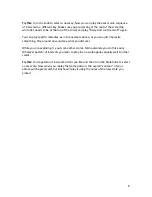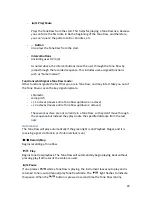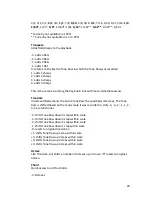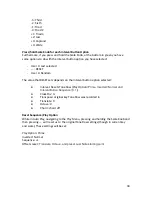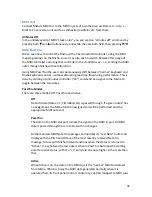
Playback:
when in this mode the green LED of the
button is on and not flashing,
and the interval button lights have reversed functionality, which is to say they are blank
except when that interval is triggered. If there is no clock, the user can now play back
the series exactly as it was recorded, by repeatedly pressing “+1”. In addition, the user
can also move through the series forwards, backwards, skipping every other note, etc.
by playing other interval buttons, which in this stage are re-purposed to be steps within
the series that has been recorded. Thus, a +/-n button will move +/-n steps within the
recorded series, not within the current scale.
Note that while the user is in playback stage, pressing
toggles a pause in the Tone
Row. Pressing play a second time will resume playback from where the user left off.
If you are in either the Play or Auto Play Menu, then you can restart the sequence on the
first note of the recording by pressing
⤺
(“RESTART”). This is useful in the case of a
pattern of odd length, in the case that you want to start it on the downbeat, thereby
“squaring it off”.
When you are finished with Tone Row Mode, pressing and releasing the
button
switches Misha from Tone Row mode back to performance mode. The latest recorded
Tone Row can be accessed at any time by pressing the
button
In the following examples it is assumed the clock - whether internal and external - is off.
Example #1
You are on middle C in the chromatic scale, and press the
button. (Note that in the
following description, each time you hear a note it will be added to the Tone Row.) You
press 0 to start (Adds C). Then pr1 will move you to C#
. Pressing -1 will move you
to B (Skipping over C as it has been used already).
Pr1 will now move you to D
(this is because we are skipping over C and C#, which we have already heard)
. Pressing
-1 will move you to A# (this because we have already heard all the notes between B and
D)
. Pressing -3 will move you to G (as normal)
. Pressing
will bring us to stage 2,
playback. (Note that in this case we have stopped the Tone Row prematurely at six of
twelve notes.) Then
pr1 repeatedly will sound C, C#, B, D, A#, G, and then again
C, C#, B, D, A#, G etc. (the sequence we recorded).
Pressing
button will play the
first note of the Tone Row, then -1 repeatedly will sound G, A#, D, B, C#, C, G, A#, D, B, C#
etc.
Try other combinations of the interval buttons to obtain interesting results.
Example #2
You select the 20 tone scale and press
. Start pressing interval buttons but this time
don't press the
button, letting the software decide to end the sequence
automatically when all 20 notes are used up. Once in the playback stage, try different
combinations of repeating interval buttons to hear some unusual patterns. By using only
a few buttons in a repeated, cyclical manner, one can create complex musical patterns.
21


